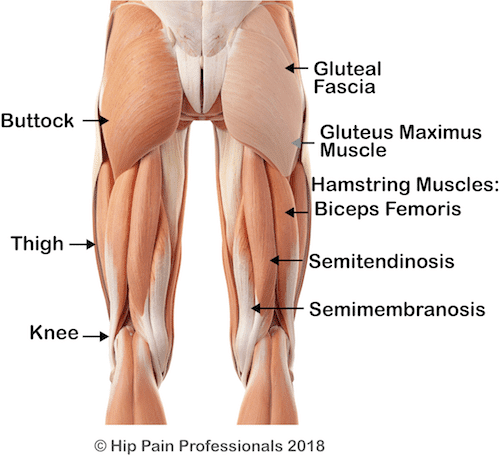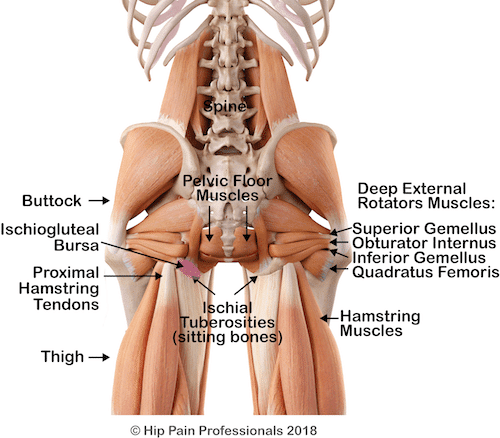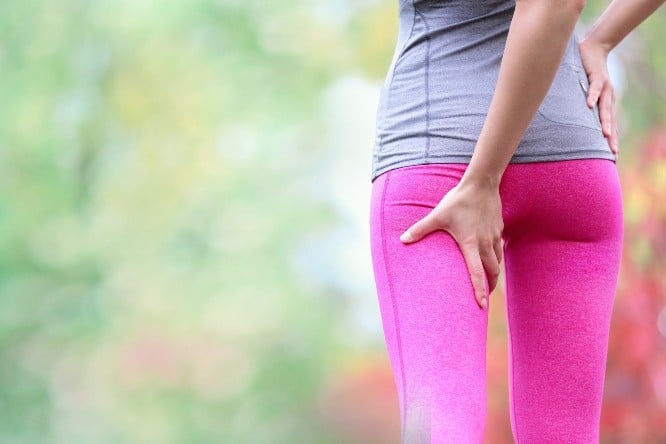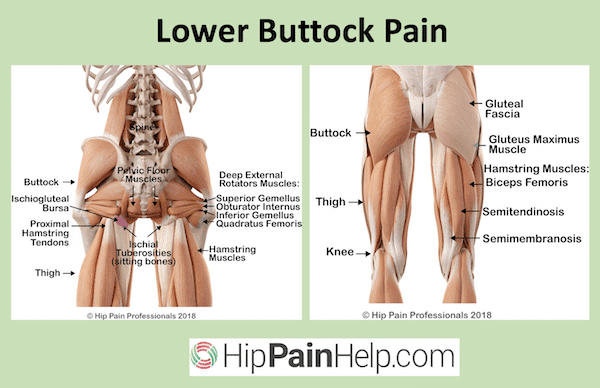
Causes of lower buttock pain may include proximal hamstring tendinopathy, ischiogluteal bursitis, ischiofemoral impingement, and pain relating to the deep hip rotator muscles.
The muscles of the lower buttock region are involved in providing support for the back of the hip joint and moving the hip into extension and external rotation – taking your leg backwards and turning your knee outwards.
If you put your hands on the lower half of your bottom you will be touching the lower portion of the gluteus maximus muscle, an important muscle for pushing up from a squat or lunge position or for extending the leg behind especially when walking up a hill or stairs.
The hamstring muscles (semimembranosis, semitendinosis and biceps femoris muscles) in the back of the thigh help to extend the hip (take the thigh backwards), but also bend the knee. This combined function makes the hamstring muscles very important muscles for transferring forces between the hip and lower leg in actions such as running, kicking, lifting and lunging.

Beneath the lower part of the gluteus maximus muscle, sit a group of small muscles, referred to as the deep hip rotators. They work to rotate the thigh and turn the knee outwards. They also have important connections into:
The hamstring muscles in the back of the thigh also attach deep in the buttock, onto the sitting bones (ischial tuberosities). Directly on top of the hamstring attachment is a small flat, fluid-filled cushion (the ischial or ischiogluteal bursa). This helps reduce friction and allows smooth gliding of the largest buttock muscle (gluteus maximus) over the hamstring tendons.

Soft tissue-related causes of lower buttock pain may occur for many reasons:

Visit our Pain Locator Map to learn more about other causes of lower buttock pain.

This blog was written by Dr. Alison Grimaldi, with contribution from one of our Hip Pain Professionals, Kirsty McNab, experienced physiotherapist.
Dr. Alison Grimaldi is a globally recognised expert physiotherapist, researcher, and educator, who has over 30 years professional clinical experience helping patients recover from a wide range of hip and pelvic conditions.

Dr. Alison Grimaldi BPhty, MPhty(Sports), PhD, FACP
Dr Grimaldi has completed Bachelor of Physiotherapy, Master of Physiotherapy and Doctor of Philosophy (Physiotherapy) degrees. She is a fellow of the Australian College of Physiotherapists, Practice Principal of PhysioTec Physiotherapy, an Australian Sports Physiotherapist , an Adjunct Senior Research Fellow at the University of Queensland, as well as an author and global educator. Her passion is helping people with hip pain, and educating other health professionals around how to help more people with hip pain.
References
4.Gollwitzer H et al (2017). How to address ischiofemoral impingement? Treatment algorithm and review of the literature. J Hip Preserv Surg v.4(4); 2017 Dec
